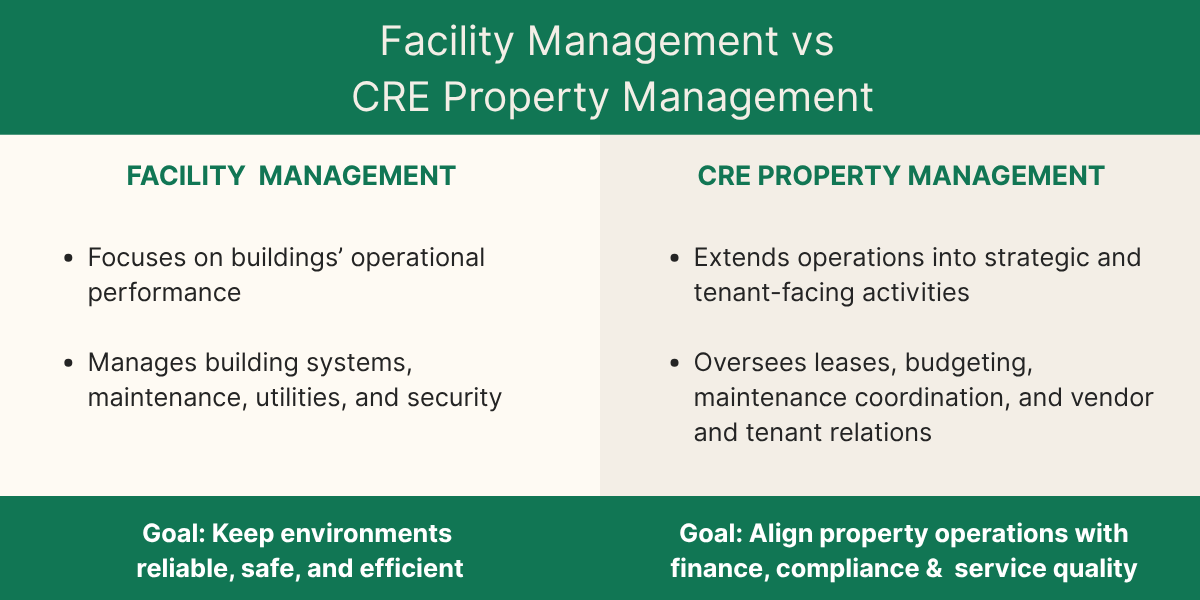Back
Glossary
Facility Management
What is Facility Management? A Definitive Guide for Commercial Real Estate Firms
Key takeaways:
Facility management involves connecting people, places, and processes within the built environment to ensure safety, efficiency, and long-term asset reliability.
In commercial real estate, facility management connects daily operations with portfolio performance, driving sustainability, uptime, and tenant satisfaction.
Visitt’s AI-native platform automates maintenance, inspections, and compliance, helping teams prevent issues, control costs, and standardize operations at scale.
What is facility management?
According to ISO, facility management, or facilities management (FM), is the organizational function that “integrates people, places, and processes within the built environment” to ensure safety, comfort, and efficiency. It combines operational and strategic responsibilities that keep buildings and infrastructure functioning while supporting the business and people who use them by:
- Improving organizational performance: Ensuring that facilities support daily operations and enable teams to work efficiently.
- Enhancing sustainability and resource use: Reducing energy consumption, waste, and environmental impact through responsible building management.
- Creating safe and engaging workplaces: Maintaining compliance while supporting comfort, accessibility, and employee well-being.
- Managing lifecycle costs effectively: Extending the lifespan of assets and infrastructure while controlling maintenance and capital expenses.
- Building resilience and continuity: Preparing facilities to remain functional and adaptable during disruptions or change.
- Reinforcing organizational identity: Reflecting brand values and culture through the design, upkeep, and functionality of physical spaces.
What responsibilities fall under facility management?
To achieve facility management goals, teams plan, track, and execute the work that keeps buildings and assets performing. They use facility management software to coordinate daily activity and long-term planning across every site and system.
Typical activities within an integrated facility management system include:
- Coordinating building operations and maintenance tasks to ensure safety, comfort, and uptime.
- Managing preventive maintenance programs through a CMMS or other facility management software to reduce downtime and repair costs.
- Using work order management software to track tasks across properties and teams.
- Applying risk management practices to prevent failures and maintain compliance.
- Managing vendor relationships and service contracts using contract management software for greater transparency and control.
- Using PropTech and AI solutions to automate routine facility management processes and analyze building performance.
Which competencies must facility managers master?
To fulfill their professional responsibilities, facility managers must be proficient in several technical and leadership areas, defined by the International Facility Management Association (IFMA) as 11 core competencies.
How does facility management operate within commercial real estate?
When it comes to commercial facilities management, operational performance is connected with asset value. It ensures that every property—whether an office tower, logistics center, or retail site—runs efficiently, remains compliant, and delivers a consistent tenant experience. Facility teams oversee maintenance, inspections, and vendor coordination, while tracking energy use, sustainability, and space utilization across the portfolio.
AI plays an expanding role in this process. Through sensors and facility management software, data on building systems, occupancy, and asset condition is collected continuously. Commercial real estate (CRE) AI models use this data to predict equipment failures, optimize preventive maintenance, and inform capital planning. These insights help CRE firms align operational spending with investment strategy and ESG objectives.
Real estate facility management also works closely with commercial real estate property management, though their roles differ. Facility management centers around the operational side of buildings, overseeing systems, maintenance, utilities, and security to keep environments functional and safe. Property management extends these operational activities into the strategic and relational domain, managing leases, budgets, vendor performance, and tenant relations to ensure that each property meets both ownership and occupant goals.

Why is facility management a must for CRE?
Facility asset management directly affects how buildings perform, people work, and portfolios scale. In commercial real estate, it connects operations with strategy, ensuring that assets remain safe, efficient, compliant, and aligned with financial objectives. Well-managed facilities reduce costs, preserve asset value, and create workplaces where tenants and teams can thrive.
Real estate is the second-largest expense for most organizations, and IBM research shows that effective space management can cut costs by up to 30%. Smart buildings with connected systems can generate 30–50% savings in energy and maintenance across underperforming properties. And projects that use digital capital-planning tools have achieved up to 45% lower project costs, while companies that maintain well-run, comfortable environments see 17% higher productivity and 59% lower turnover.
The benefits of smart facility management include:
- Optimized space and occupancy planning that lowers operating costs and supports hybrid work models
- Predictive maintenance programs that extend equipment life and reduce repair spending
- Energy efficiency and sustainability tracking that meet ESG and Net Zero benchmarks
- Accurate capital and lease planning that guide investment and renewal decisions
- Tenant experience management that keeps satisfaction and retention high
- Integrated compliance and risk oversight that prevent disruptions and penalties
Thanks to the power of AI, facility management has become predictive instead of reactive. Intelligent platforms learn from equipment, energy, and occupancy data to prevent failures, reduce waste, and extend asset life before issues occur. In a sector where margins and uptime define success, can CRE firms afford to manage without it? Strategically and operationally, the answer is a resounding “I think not.”
How is facility management used in commercial real estate?
Facility management for commercial real estate now relies on continuous data collection and analysis, using AI-driven analytics to transform building operations into measurable performance outcomes across several use cases.
Preventing failures before they happen
Facility management apps help managers review maintenance records, equipment behavior, and environmental conditions to identify recurring issues or early signs of failure. When AI-driven analytics detect unusual patterns, like a change in energy draw or temperature variance, work orders are triggered, preventing unplanned downtime, lowering maintenance costs, and extending the usable life of HVAC, electrical, and other core building facility management systems.
Improving space and service planning
Facility managers apply occupancy and usage data to understand how tenants and employees interact with spaces. Access logs, booking activity, and usage trends help determine where service levels or maintenance frequencies can be adjusted. If a meeting floor is rarely used, for example, HVAC zoning and cleaning schedules can be scaled accordingly. Over time, these insights inform capital planning, tenant experience improvements, operational cost reductions, and energy use control, without affecting service quality.
Compliance and ESG management and reporting
Facility management systems now serve as reliable sources for compliance documentation and ESG verification. Automated reporting tools use collected data to generate accurate environmental and health-and-safety documentation, helping facility managers demonstrate compliance with relevant regulations and sustainability best practices.
What does facility management look like with Visitt?
Visitt brings every element of facility management—maintenance, inspections, compliance, and vendor coordination—into one connected facility management platform. The system learns from real-time operational data across every building to predict maintenance needs, automate routine workflows, and maintain audit-ready documentation. Facility teams can act proactively instead of reactively, preventing equipment failures and keeping operations consistent across all sites.
Built for scalability, Visitt enables facility management companies to standardize processes across multiple properties while adapting to each site’s specific requirements. Its AI-native design connects facilities, people, and data in real time, giving teams full visibility into building health, performance, and compliance. The result is measurable: reduced downtime, faster response times, higher tenant satisfaction, and better-informed capital planning.
See what AI-powered facility management can do for your portfolio
Ready to see Visitt in Action?
